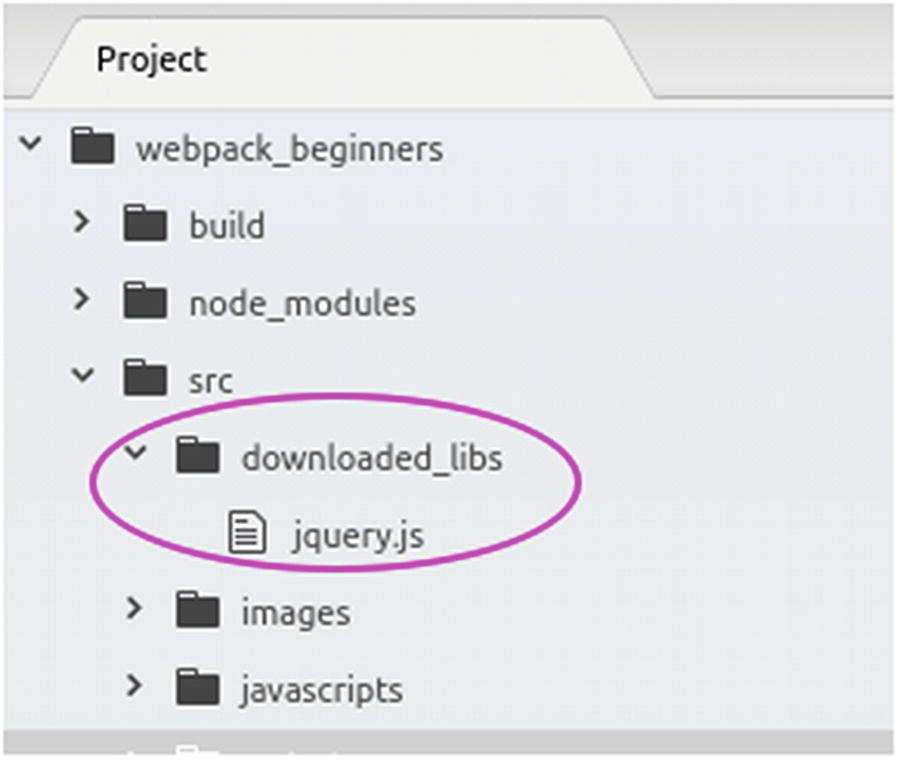After seeing how to prepare our file for caching and exploring the necessary plugins for that purpose, it’s time to tackle a new chapter dedicated to folders: how to replace their path by aliases and how to resolve modules from them. It might seem like I’m saying something strange here, but you will understand what I mean in few minutes.
Organizing Our Files
- 1)
We are going to create three folders in our “src” folder: one called “javascripts,” one called “stylesheets,” and one called “images.”
- 2)
We are going to move our JavaScript files to the “javascripts” folder, our CSS/SCSS files to the “stylesheets” folder, and finally our image files to the “images” folder. You can see the new structure in Figure 5-1.

Grouping files with same extension in organized folders

Webpack can’t resolve our CSS files after changing their location
Make sense? I hope so. Now if we compile our files using the “npm run build,” we will get everything working correctly.
Aliases
This is tedious to write, but of course I’m not encouraging you to use a complex folder structure in your project. In some situations, you may face things like that or maybe you are working on a legacy project that is structured in a horrible way. This is why I want to talk about something useful for these scenarios, which we call an “Alias” or “Aliases.”
As expected, everything is working perfectly. The only difference is that now the path is cleaner.
Just for the sake of remembering, whenever you make a change to the configuration file, you should rerun the webpack (build) command, even if you are using the watch mode.
Aliases can be very handy for many situations. It’s something you want to think about whenever you face a situation where you group your files in different subfolders or you just have some relative paths that look awful to type.
Resolving Modules
While we are talking about the webpack “Alias” resolver, I want to mention another helpful resolver, which is “resolve.modules.” What this does is tell webpack what directories it should be looking in when resolving modules.
Now webpack will look in “downloaded_libs” folder first, then if the module we are looking for doesn’t exist there, it will continue the search in the “node_modules” folder, which is the “default.”

Creation of a separate folder to contain our third-party library (jquery.js)
You can use whatever alias you want. I’m using a dollar ($) sign here in order to refer to the jQuery object, because that’s the convention for jQuery, but it’s up to you if you prefer to use jQuery or jq or something else. Just make sure to call the proper alias; for example, instead of using $('.selector'), you will have to use your custom alias, like jQuery('.selector') or jq('.selector'), etc.
Note that we did not use a relative path (i.e., ‘../downloaded_libs/jquery’) because as we discussed before, webpack is now able to look for the “downloaded_libs” folder automatically when importing modules.

Appending text via jquery using “resolve module” option
You can see that it’s possible for you to add a custom folder like we did and copy your third-party JavaScript libraries into it, then let webpack figure that out for you using the “resolve.modules” option. However you will miss the power of your package manager (npm or yarn), which you would prefer to use instead of downloading manually your libraries.
I have just shown you this option to be aware of it in case you want to use it for specific cases. But I would still recommend using npm or yarn to download your JavaScript libraries and import them in your code, we will talk more about this subject in the last chapter of this book.

Webpack warning about our application.js size limit
For now, ignore this warning, it’s really not that important, and not all warnings are bad, including this one. We will discuss more about this later.
Summary
In this chapter, we have organized our files, seen the usage of aliases, and shown how to resolve modules from a custom folder. You can see now how flexible webpack is, and how you can make things organized in the way you want or prefer to. I hope in this chapter you learned something that will serve you in the future, as I’m sure there are many cases where you will need to refer back to the techniques described here. In the next chapter, we will explore Webpack Dev Server, which is a lightweight server that comes with webpack out of the box in order to make your development work easier.
